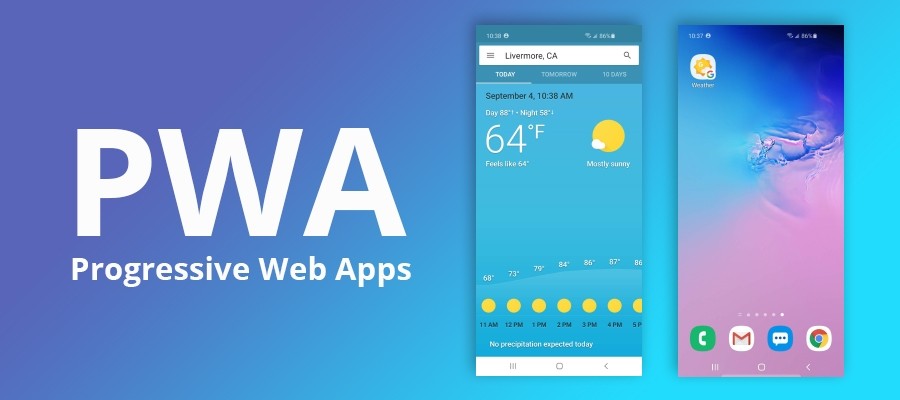The following conversation took place on the eCommerce-Aholic channel, between the show’s host TJ Gamble, CEO of Jamersan, and Jay Smith, Founder and CTO of Webscale. In Part 2, they look at the cost implications of moving to a PWA, from both a hosting and developer perspective.
The content has been lightly edited for consistency.
TJ: The fact that PWAs use less computing power to generate the site, theoretically, merchants could see a reduction of your costs. But there are other different complexities that could add to the cost. From what you’re seeing so far, is it substantially more expensive or is it about the same to host a PWA?
Jay: It’s going to vary by site. Somebody who’s got a very high conversion rate, lots of checkouts, is not going to see much of a difference. You still have a lot of API calls, a lot of customer management, a lot of data transfer, as well as compute that has to happen on the back end to deliver that unique data and user experience down to the customer. You are still running a cluster to service your checkouts and the customer-specific data in the session track, that’s going to drive the cost. For the PWA piece, it’s almost the same. We may be running a cluster to service these components, but they are not very compute intensive. The delivery of these assets is almost equivalent to delivering static assets, so they’re very cacheable and they don’t create a lot of extra compute needs on the hosting side.
So in terms of being able to service that application with a fully hosted Magento PWA Studio, I see it as pretty flat. While you give up some cost in some areas, you gain some cost in others. So, the hosting costs won’t change a lot. In fact, you could potentially realize a reduction in cost by outsourcing the entire back end. So, if I’m not hosting the shopping cart, now, all of a sudden, there’s a big source of expense that goes away, as well some security concerns.
For smaller merchants, by outsourcing that to a SaaS provider, there are some wins to be had because you’re handling less of the user-specific checkout experience. That means you’re shifting the burden of PCI compliance onto somebody else to some extent. Now, you still are part of the cardholder data environment, you still have PII data, so there’s still a security concern, but it’s somewhat reduced and it can be a good decision for merchants.
TJ: When moving to a PWA, are there any decisions that merchants can make that have a profound impact on hosting cost?
Jay: How you decide to build that application can have a huge bearing on hosting cost. I’m a big fan of treating the website as a single page JavaScript application. While there are difficulties there, and I have to be sensitive to the computer resources of my client, I’m a big fan of basically having the whole website as a static asset. It opens up some delivery, so now my web server becomes, for example S3, and I don’t necessarily have to expose that to the internet. I can lay out my entire site as a bunch of static assets which look like a static application, yet it’s making API calls and the dynamism is coming from the application which is running in the browser and fetching data from the origin to deliver the user experience that I want. In terms of costs that helps substantially, because a static website hosted in S3 only incurs the cost of data transfer, which is crazy cheap.
I don’t necessarily want to expose that to the internet directly, so you do want that proxy layer, something in between where you’re putting these assets and your delivery to the internet. I’m a big fan of our proxy services for this, namely the mechanism of using our proxy to front end S3 delivery and a dynamic back end for controlling the marketing experience. The dynamic back end that’s tailoring the site, and the assets to the user that’s visiting the site, I still want that active cluster there servicing those requests, fetching state, and delivering it into the browser. This is more efficient and beneficial to costs in terms of just the hosting piece, but when you look at it, you have all the same moving parts, so don’t necessarily expect a drastic reduction in costs. What I do see, though, is increased availability and increased performance.
A lot of the issues of the past tend to go away, though not for free. There’s more thought into the delivery and the build up front, but it tends to be a much more efficient approach to total site delivery. So while it is a more complex delivery environment, the end result is a much better user experience which should translate into increased revenue for the site.
TJ: How do development costs and time-to-go live change when it comes to PWA and Headless?
Jay: I would expect to see some increase in costs for a PWA site done well, because there’s going to be more testing that’s required, more customization, and a more unique user experience. You’re going to have to invest more into owning and managing that, as well as testing it to make sure that it’s working the way you expect it to.
But it’s also likely to be more expensive than a traditional deployment right now, because you’re a pioneer. Not everybody has developed using these new technologies yet, or maybe they’ve done a few but not hundreds, so there’s going to be a learning curve there as well. The tooling is still fairly new – they’re still actively adding functionality to all these PWA frameworks, and while it’s getting more robust every day, it’s still in development. That’s going to require you to sometimes review those tools and try to figure out how to do something. All that said, I don’t think it’ll be long at all until a traditional site and a PWA will be of similar cost.
But long term, the power of PWA, again, is not in building out a traditional use case. It’s in being able to really craft an experience. You got to think of it more like a native app than a website. What can we do? What boundaries can we push? And there’ll be a lot of companies, especially enterprise companies willing to do this. I think it’s going to be huge for B2B once they finally come around to doing ecommerce properly, because a lot of those experiences need to be tailored. Once they start doing PWA well, I think the average cost will go up because that segment will invest more heavily, and that will bring that average up. But I think it’ll stay in the realm of feasibility for small merchants who want more than just a basic website.
Be sure to check back for Part 3, where Jay and TJ will discuss the different hosting environments for PWAs, and how best to manage and troubleshoot those deployments. For the full livestream interview, click here.














